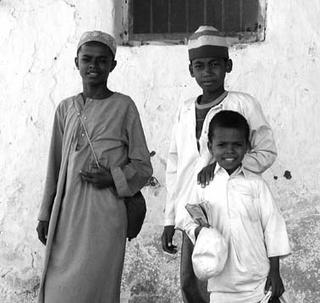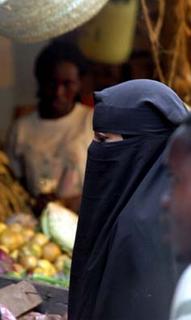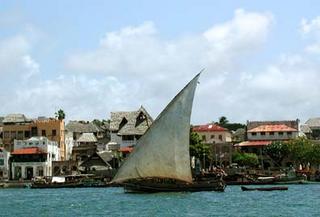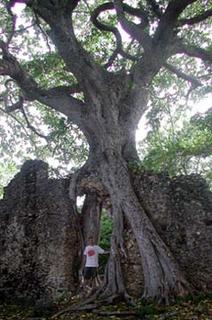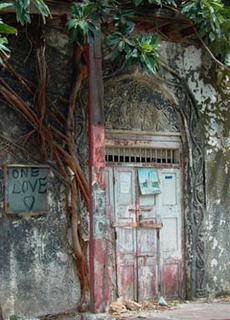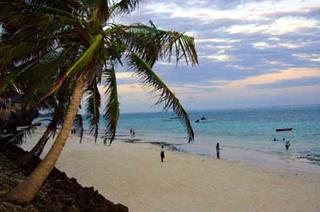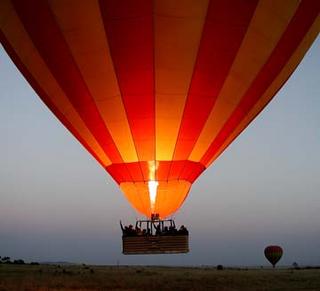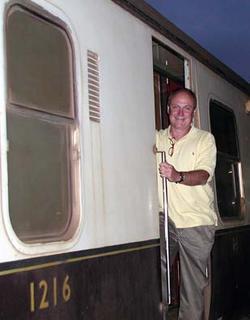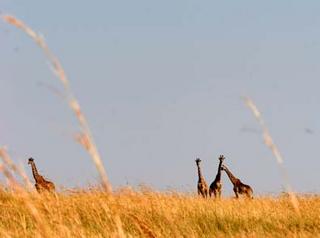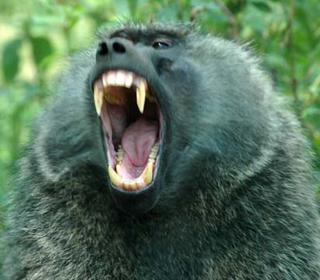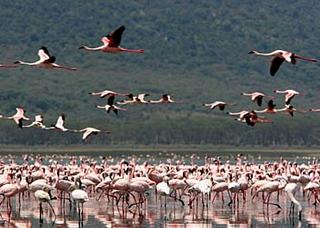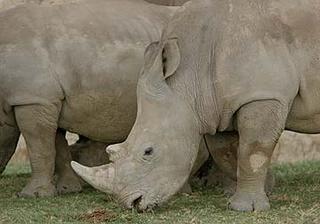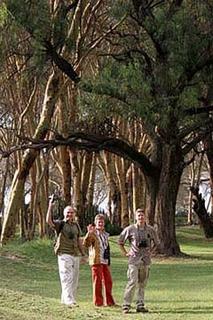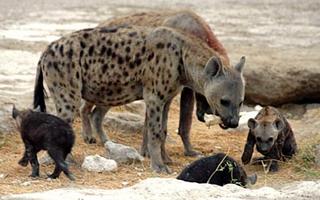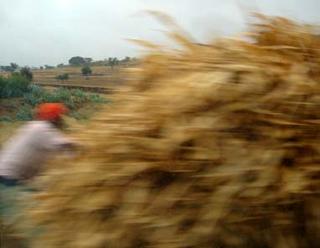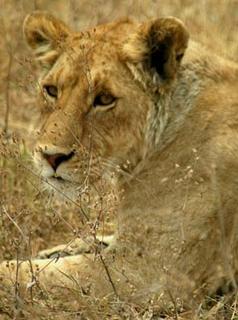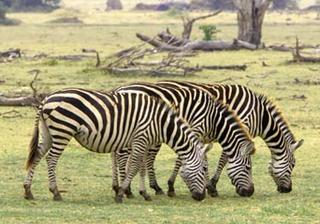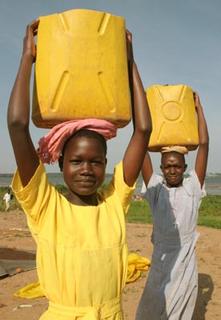18 August -- Tsavo (by Roger)

Today was just the way I wanted to spend my last safari day in Kenya.
After the adventures of the night, we got up fairly bright and early and had a small, fast breakfast here at the Italian Camp. We weren’t sure what we were supposed to eat (if anything), and practically everyone was gone, so we chowed down on the toast and coffee that was offered and set out for a combo of a game drive/get-to-the-other-side-of-Tsavo-where-we-were-supposed-to-have-stayed-at-Patterson's-last-night. The coffee was excellent, incidently – fortissimo espresso made in one of the little stovetop steam pressure makers I used to use in France.
Though we seem to say this wherever we go, I do think Tsavo is one of the most beautiful parks in Kenya. It’s all semi-arid bush – mostly 5’-7’ leafless acacia trees with mega-thorns and scrub underneath that. The colors are arresting. This day, the sky was a deep bluish grey, the soil a Georgia red clay, the bush a range of light greys with some greens mixed in. There was also a peppering of yellow blooms from one species of acacia that flowers in the dry season when there are no leaves. When the ground isn’t flat, there are outcroppings of cracked, red boulders. The landscape is broken, tough and ancient.
Running though this landscape is the Tsavo River, and it is a wonder to see. We followed this river for a lot of our drive to the next camp. The Tsavo is wide, shallow and meandering, and as it turns through the arid landscape, it’s a wide band of blue with small borders of light green on both sides, the trees that line the banks. Whenever you get a clear view of the river, you see sandbars in it, and there are often animals there, too. We mostly saw hippos and crocodiles, though there was ample evidence of elephants and Cape Buffalos, too. It was hard to resist getting out of the car, running down to the sandy banks and jumping in the flowing water. Not too hard, though. We could see the crocs, and we knew there were lions we couldn’t see. It was on a hill just above the Tsavo that I scattered some of Mark’s and Greg’s ashes that Caroline had left with us.
The animals here are really unique. One big surprise was that there are many, many of David’s totemic animal, the Dik-dik. These are beautiful little antelopes that are slightly bigger than a Chihuahua, and they are normally very shy because practically every animal in the bush preys on them, including birds. Perhaps because it was sort of overcast, we saw lots of them. They mate for life, so you usually see them in pairs, but we also saw some in trios, the third one being a baby. With their huge, almond-shaped eyes and graceful little bodies, they look more like a Walt-Disney creation for an early animated film than a real animal shaped through natural selection to thrive in this environment.
We saw other unusual animals, too, all sharing the characteristic of elusiveness. One I simply called a giraffe-alope (Justus called it a gara-something); it’s an antelope with a long neck! I guess its neck lets it see over distances a bit bigger than the normal antelopes can, but it’s still one unusual-looking beast. Another shy animal was the Lesser Kudu. This is a bigger, stockier antelope, and its outstanding characteristic is having vertical white strips on its sides and an uneven overall color scheme that includes blueish grey and brown. We could only catch glimpses of both of these because they vanished into the bush as soon as they caught sight of our car.
The arid, scrubland birds were pretty amazing, too. There were brightly-colored bee-eaters and rollers, loud hornbills, and many other smaller birds with wild colors and patterns. We also saw excellent scavengers and birds of prey (like the common but striking and huge Bataleur Eagle), and we got a look at the outrageous bird on the cover of our book, the Red-and-yellow Barbet. Even the starlings are bold and beautiful here.
As the road mostly followed the river, we stopped a couple of times for views. At the first stop, Crocodile Point, we walked down to an overlook and watched a crocodile patiently trying to trap a bird by lying in the sun with his mouth wide open. Birds wisely avoided walking into the croc’s mouth during the half hour we were there, but David pointed out that the strategy must sometimes work or the croc wouldn’t be doing it. The next stop was at Luggards Falls. There was no falls visible here when we got out of the car; we only saw a huge flat surface of granite. We could also see the wide river come into the granite field and vanish. When we walked up to the point where it vanished, we realized that the whole river was funneling into a very narrow crevice in the granite and raging though the field before becoming a calm, wide river again below us. This was a great sight.
We eventually left the park following the underground aqueduct that carries water all the way down to Mombassa. There were big herds of zebra, antelope and giraffes in this area, and Justus explained to us that the authorities let the underground water pipeline leak some water at this point to provide for the herds. We also saw a couple of herds of the famous Tsavo red elephants in this area. The elephants wallow in the water here and cover themselves with the red dust of Tsavo, hence earning their name. In fact, we even saw some elephants in a dust fight, doing exactly this same thing.
After a snack and some gas on the Mombassa/Nairobi road, we headed on into another section of the park, this part being where our camp was. The road was rocky here, but there was the same beautiful landscape. Then we finally came to our place, Patterson’s Safari Camp.
David and I loved this place the minute we saw it. It reminded me of Siana Springs camp because of the canopy over the tent, the tent toilet facilities and the rustic ambience. But the resemblance ended there. This camp consisted of a bamboo reception area and restaurant in the trees on the bank of the Tsavo with a half dozen tents spread single file to the right and left. Each tent overlooked the river with its sandbars and wildlife. The camp had a gourmet lunch already prepared for us when we arrived, and we ate it on the veranda of the dining room, watching a hippo sleeping on the opposite bank of the river and a Grey Kingfisher squabbling with a Buffalo Weaver to our right. We’ve had some outstanding soups here in East Africa, but the vegetable-and-ginger soup we had here was among the best. This was a great end to a long morning game drive.
We next had a short nap, after which the staff brought us some coffee that we drank on the little veranda of our tent. While we stared out at the Tsavo, we talked about how wonderful this area was and how much we didn’t want to leave. We finally roused ourselves though, and we went for our afternoon game drive.
Wildlife is not as abundant in Tsavo as in Masai Mara, and it’s not as easy to see it in the scrub as it is in the plains, but there was still a lot of kudu, dik-dik and birds to attract our attention. For both of us, too, there was a lot to be said for just standing and looking out the roof of our van at the landscape and the river. I also finally got a photo of a termite hill as we were driving along, the achievement of a goal I’d set in Uganda. We’ve learned a fair amount about the importance of termites and their mounds to the ecology of areas like this. For one thing, we noticed that the big majority of mounds have a tree growing out of them. We found out that animals like aardvarks dig into the mounds looking for termites. After the mounds have been opened, birds pile in looking for a meal, too, and both birds and animals drop seeds in the mounds while feeding. Though termites remove most of the seeds, the cool, moist interior of the mounds promote germination of seeds that are left, and a tree sprouts. As the tree grows and the roots take over the mound, the termites have to move and start another mound. While many trees have mounds at their base, nearly every mound has tree coming out of it. I chuckle at the irony of termites being such an important component in the growth of trees in this area.
The mounds serve other purposes, too. As dusk came on, we saw several Dwarf Mongooses scampering into a big termite mound that looked like a castle. Justus pulled our car up to the mound, parked and told us to watch. Pretty soon, little mongoose heads started popping up out of the top of the cylinders of the termite hill and from around the sides, looking at us. We’d seen these cute little creatures in Siana Springs (where they lived under our tent’s porch), and they were even cuter here.
Back at the tent, I was taking a shower and shaving when David yelled at me to turn off the water and listen. I did but didn’t hear anything, and David asked if I was deaf. I learned why a few minutes later when some loud, hoarse cry came out of the bushes just down from our tent by the river. For reasons we didn’t understand, our tent was on the far edge of the campground, and I think we were the only party in that entire wing of the camp. We felt vaguely like animal bait for the camp.
After David showered, I heard the same noise again, only this time accompanied by very loud crashing noises right outside. At this point, I decided to skip dinner and stay in the tent until sunrise, but David always has to eat, so we tried to creep out of the tent and make it to the walkway to the reception. More loud noises, more loud crashing in front of our tent by the river. We ran to the reception.
The staff was quite calm about the elephants going around (and through) the camp, but I can only speculate that I’d have been calmer, too, if our tent had been closer to the center of the camp. In any case, dinner was magnificent, and we celebrated our last night in the bush with a half carafe of wine. I added a gin-and-tonic.
We decided to skip the bar’s showing of The Ghost in the Night, the Val Kilmer film about the hunter Patterson and his struggle with some killer lions in Tsavo. These events transpired near our present camp site, and we didn’t want to dwell on the theme. Fortunately, the crashing around our tent had subsided enough by this time for us to get back in, and once safely there, we immediately opened the window flaps so we could see from which direction the immanent attack would be coming. We both slept fairly lightly, awaking to the occasional cry and crash. David saw a herd of antelope go by his window in the light of the full moon, but they apparently didn’t make the volume of noise necessary to wake me up after a day such as this.
